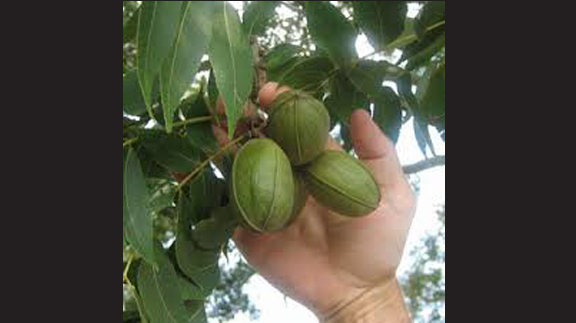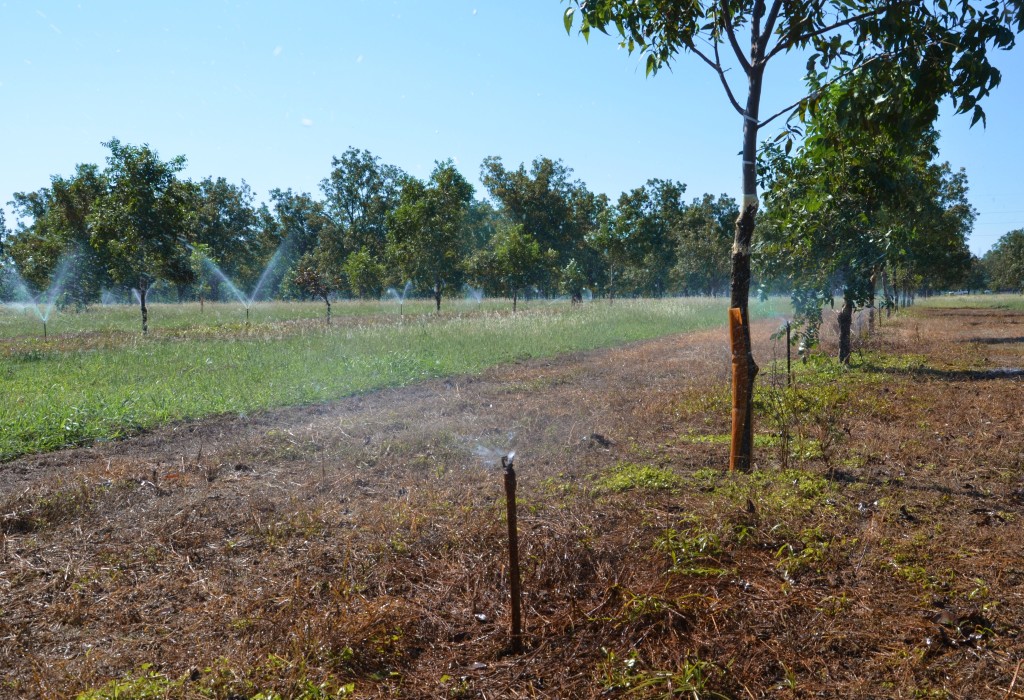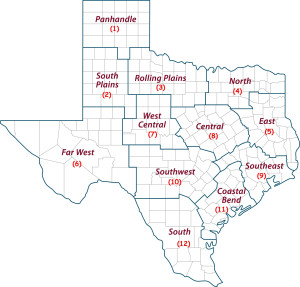Farm & Ranch
Texas AgriLife Extension crop, weather report for Oct. 27, 2015

By: Robert Burns
For most Texas pecans, Hurricane Patricia was the perfect storm
Writer: Robert Burns, 903-834-6191, [email protected]
COLLEGE STATION – Heavy rains in many parts of the state may have damaged some crops, but for this year’s pecan crop, it was “just what the doctor ordered,” said a Texas A&M AgriLife Extension Service specialist.
Comprehensive reports of damages to row crops and structures such as fences and roads are not in yet, but in most cases the rains and cooler weather couldn’t have come at a better time for pecans, said Dr. Larry Stein, AgriLife Extension horticulturist at Uvalde.
“Pawnee, the earliest commercial pecan variety, has been harvested, and most people were working on Wichita and starting in on Cheyenne pecans,” said Stein. “But some of these varieties have a ways to go. They weren’t totally full. So this rain we just received was very beneficial to finishing out the kernel and causing the shucks to open on the trees.”
Download or preview a two-minute MP3 audio version of this report
Far West Texas pecan growers anticipate dry weather during the growing season and typically have enough irrigation capacity to see the crop through a drought, he said.
Pecan growers in other parts of the state usually do not have adequate irrigation systems for their orchards. If they do, their systems may have only enough capacity to supplement the crop’s water needs, not offset months of drought, he said.
“And make no mistake about it, irrigation is just not as good as rain,” Stein said.
The main effect of water stress is for the nuts not to completely fill out, he said.
“Typically, then the nuts have trouble opening up, and when they have trouble opening up, then there’s a chance for the nuts to sprout and the shuck to stick tight to the nut itself,” he said.
The cooler weather accompanying the storms was also ideal for the crop.
“The cooler weather actually causes the maturing to go faster,” Stein said. “Out west, they hope for freeze to knock the leaves off the tree and help open up the shucks.”
There might be instances where the rains were too much, too fast, such as where 10, 12 or 18 inches of rain fell.
“Too much rain can cause the nuts to sprout, depending upon the stage of maturity,” he said. “But I don’t expect that to be a common problem this year.”
And there were instances of hail storms severely damaging pecan orchards this year in El Paso County, but that is a risk growers face every year, Stein said.
Climatologists posted the first hurricane watch early in the morning of Oct. 21, just six hours after Patricia was named a tropical storm, said Dr. John Nielsen-Gammon, state climatologist and Regents Professor at Texas A&M University, College Station.
“The median rainfall total for the event across all reporting gauges in the state, partially adjusted for data coverage, was 3.95 inches,” he said. “The biggest surprise to forecasters with this event was that the rain was concentrated in Texas rather than spread over a wider area. For northern Oklahoma and central and eastern Kansas, which were also expecting lots of rain from this event, it was a complete bust.”
AgriLife Extension district reporters compiled the following summaries for the reporting period of Oct. 20–26:
Central: Soil moisture, livestock, rangeland and pasture were rated as being in good condition. Crops were in fair condition. From 4 to 15 inches of rain caused severe flooding in some areas. Many wheat fields were expected to have to be replanted. The wet conditions delayed cotton harvesting, but benefited pastures and rangeland. Runoff filled stock-water tanks and streams. The Brazos River was up to its banks. Producers were providing livestock with hay and supplemental feed.
Coastal Bend: The region received from 2 to 8 inches of rain, which raised soil moisture. Winter pasture seed that had been lying dormant in dry soil was expected to emerge soon. Many producers, responding to the forecast, applied fertilizer before the rains. Ranchers hoped the rain would spur forage growth enough to allow one more hay cutting. Pecans were being harvested with low to fair yields. Fall calving continued.
East: The entire region received much-needed rains, with accumulations of more than 11 inches. Many producers had planted winter pastures in anticipation of the forecasted rain. Stock-water ponds were replenished. Most of the rain fell slowly, and there was very little runoff. Producers hoped to soon see regrowth in cool-season grasses. Cattle remained in good condition with producers providing supplemental feed and hay. Weaning of fall calves continued. Most spring calves had been sold. Prices of steers and heifers were steady to $7 per hundredweight higher. Houston County calf prices were slightly higher. Some producers had been selling because of the drought conditions. Feral hog problems increased.
Far West: The region received from 1 inch to 7 inches of rain, with Upton County getting the most. The rain slowed or halted all field activities, including cotton harvesting and the planting of winter wheat. In El Paso County, hail damaged many crops – some pecan farmers reported 100 percent losses. Producers in Brewster and Jeff Davis counties were in the middle of fall cattle working. Weaning weights were good, as well as the overall condition of cattle. Pastures and rangeland were in good to fair condition.
North: Topsoil moisture was short at the beginning of the reporting period but surplus in some areas by the end. Hurricane Patricia provided some much needed drought relief Oct. 23-25, bringing from 6 to 7 inches of mostly slow-falling rain. The rain was probably too late to revive warm-season grasses but should be good for wheat and winter pastures. Anticipating the rain, producers amped up wheat planting the previous week. The runoff raised pond levels and caused flooding and erosion of fields and farm-to-market roads. Saturated soils and standing water may pose problems for future production of wheat and other forage crops. Wild hogs were still causing costly damage to fields.
Panhandle: Temperatures were near normal for the week. Rainfall ranged from 0.5 inch to as much as 7 inches in some areas. Harvesting was halted by rain throughout most of the region. Collingsworth County received from 1.5 to 2 inches of rain that halted harvest activities but benefited earlier-planted wheat. Dallam and Hartley counties received 2 to 4.5 inches of rain this week. So far this year, the county has received 20 to 25 inches of precipitation, which is about 5 to 8 inches above normal. Because of forecast cool temperatures, it was expected to take some time before fields dried out enough to resume harvest activities. Deaf Smith County got 2 to 7 inches of rain, with 4 inches common. Lipscomb County received 1.3 to 2.4 inches, but that was enough to bring harvesting to a standstill. Moore County got 4 to 6 inches of rain. Randall County received 2-4 inches, which delayed harvest, but was excellent for recently planted winter wheat. The sorghum harvest was nearly completed before the rain, with yields varying from 2,000 to 8,000 pounds per acre – the average was about 4,000 pounds per acre. Corn harvesting was mostly completed, with yields of about 240 bushels per acre.
Rolling Plains: The region received as much as 5 inches of rain in some areas. The rain halted cotton stripping but helped producers who wanted to plant wheat for grazing. Livestock were in good condition. Rangeland and pastures were also in good condition. Runoff helped replenish reservoirs and ponds.
South: The region received widespread rains as a result of Hurricane Patricia and another weather system in the upper and mid parts of Texas. In the northern part of the region, the peanut harvest was in full swing and the cotton harvest was winding down. Harvesting was interrupted by rain at the end of the week. Oats and wheat began to emerge. Producers also continued to plant wheat and oats. In McMullen County, rainfall amounts ranged from 1 inch to 3 inches, which improved soil moisture but most likely came too late for the summer perennial grasses. Soil moisture was mostly adequate in the northern counties. In the eastern part of the region, from 1 inch to 6 inches of rain helped improve rangeland and pastures. Soil moisture was mostly adequate in the eastern counties. In the western part of the region, rains boosted grass growth and pasture greenup. Supplemental feeding of livestock was minimal; in some cases, no supplemental feed at all was required. Cotton gins continued activities, but were expected to finish by the end of October. Cabbage and spinach crops made good progress. Some early planted cabbage fields will be ready for harvest in the first week of November. Pecan harvesting was active. Wheat and oats emerged thanks to the recent rains. Soil moisture was mostly adequate in Dimmit and Maverick counties, but short to very short in Zavala County. In the southern part of the region, fields and pastures were saturated after heavy rains. The end of week brought ample moisture with strong rainfall to the Cameron County area, saturating fields and pastures throughout the area. Vegetables progressed well, and draining of irrigated fields with vegetables continued. By the end of the weekend, more than 4 inches of rainfall was reported in the Cameron County area. In the Hidalgo County area, winter vegetable planting continued. In Starr County, fall vegetable crops were progressing well. Rangeland and pastures continued to improve. Soil moisture was 100 percent surplus in Cameron County, and 100 percent adequate in Hidalgo and Starr counties.
South Plains: Rainfall varied from 1.5 to as much as 7 inches, which halted cotton and corn harvesting for several days to a week. The effect of the rain on cotton lint and grain quality was not yet known. The rains benefited pastures and winter grasses. Cattle were in good condition. Rainfall amounts were: Floyd County, from 2.5 to 3.5 inches; Swisher County, 3.5 inches; Crosby County, as much as 5 inches; Lubbock County, from 1.5 to 4 inches; Garza County, 2 to 3.75 inches; Mitchell County, 3 to 7 inches; and Scurry County, 3 to 4 inches.
Southeast: Soil moisture varied widely, but was mostly adequate to surplus, with adequate being the most common rating. Rangeland and pastures varied widely too, being mostly fair to poor, with fair ratings the most common. Rainfall amounts varied widely too. Brazos, Galveston, Chambers and Lee counties received heavy rains. Chambers County accumulations totaled 6 to 10 inches. Brazoria County only received light showers. Montgomery County got less than 0.1 inch, and dry conditions persisted in Waller County. Fort Bend County remained dry enough for producers to catch up on fieldwork. A burn ban remained in place in Waller County.
Southwest: The region received from 1.5 to 4 inches of rain. Most producers had winter wheat planted before the rain, though many had to rush to get it done ahead of the rain. Many ranchers also seeded winter grasses and put out some fertilizer. Brush and grasses responded to the rain, but growth was slow with the cooler weather. The condition of livestock slightly improved with the greener grasses. Wildlife continued to be in good condition.
West Central: The region had milder temperatures with very cool nights. Heavy rains, a side effect of Hurricane Patricia in Mexico, fell in many parts of the region. Some flooding occurred, along with damage to roads and fences. Some creeks became impassable at times, and ranchers had to repair water gaps. Stock-water tanks began to fill from runoff. Many producers started applying fertilizers and planting oats and wheat just ahead of predicted showers. Winter wheat planting was expected to resume when field conditions allowed. The cotton harvest was in full swing but was then delayed by the rains. Some yield and quality loss was expected. Rangeland and pastures were expected to respond well to the rains. Livestock remained in fair to good condition. Cattle prices remained high.
-30-
Find more stories, photos, videos and audio at http://today.agrilife.org
Farm & Ranch
Hazards of Backyard Poultry

By Barry Whitworth, DVM
Having backyard poultry is a popular agriculture enterprise. According to the United States Department of Agriculture, 0.8 percent of all households in the United States have chickens. People keep chickens for a variety of reasons with table eggs being one of the more common reasons.
Unfortunately, some of these poultry producers are not aware of the hazards that come with keeping poultry because many times they carry pathogens but appear healthy.
Chickens are carriers of several zoonotic diseases. These are diseases that can be passed from animals to humans. According to a recent survey in Pennsylvania, a majority of backyard poultry producers were aware of the dangers of avian influenza. However, this study also revealed that far fewer producers were aware of the risk of possible exposure to Salmonella and Campylobacter.
The lack of knowledge about the hazards of raising poultry likely contributes to the continued issues of Salmonella outbreaks associated with backyard poultry. In 2023, the Centers for Disease Control and Prevention reported 1,072 illnesses of Salmonella linked to backyard poultry, and 272 of those patients required hospitalization. Oklahoma reported 43 individuals with the disease.
To read more, pick up a copy of the April issue of NTFR magazine. To subscribe by mail, call 940-872-5922.
Farm & Ranch
Ag Elsewhere: Wyoming

By Tressa Lawrence
Babies are tucked away in every nook and cranny. Many ranchers across Wyoming have baby animals popping up all over this time of year.
Farm & Ranch
Ag Elsewhere: Montana

By Lindsey Monk
Another load of grain in to keep feeding the calves until the green grass can really start popping.
-

 Country Lifestyles1 year ago
Country Lifestyles1 year agoScott & Stacey Schumacher: A Growth Mindset
-

 Equine7 months ago
Equine7 months agoThe Will to Win
-

 Country Lifestyles7 years ago
Country Lifestyles7 years agoStyle Your Profile – What your style cowboy hat says about you and new trends in 2017
-

 Country Lifestyles4 years ago
Country Lifestyles4 years agoAmber Crawford, Breakaway Roper
-

 HOME7 years ago
HOME7 years agoGrazing North Texas – Wilman Lovegrass
-

 Country Lifestyles7 years ago
Country Lifestyles7 years agoDecember 2016 Profile, Rusty Riddle – The Riddle Way
-

 Country Lifestyles8 years ago
Country Lifestyles8 years agoJune 2016 Profile – The man behind the mic: Bob Tallman
-

 Outdoor9 years ago
Outdoor9 years agoButtercup or Primrose?








